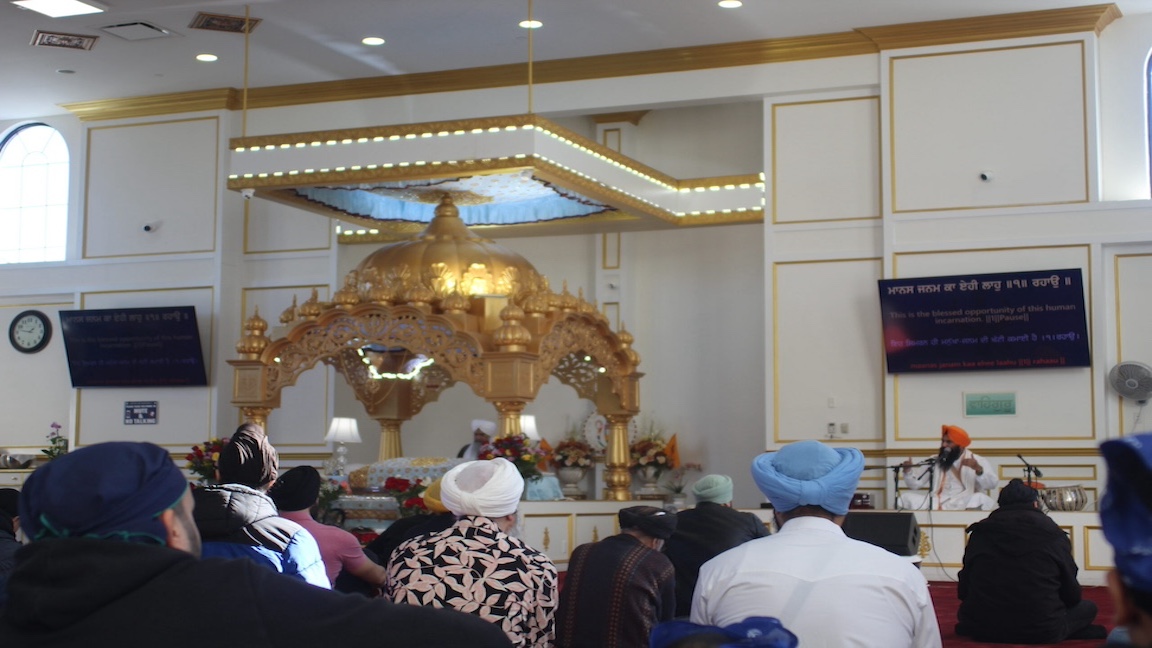
PLAINVIEW, N.Y. — The voice of the priest at the Sikh center grew louder on a recent Sunday afternoon as he delivered his final message.
“God doesn’t reside in the room; God resides within us,” he said.
As he spoke, the Guru Gobind Singh Sikh Center on Long Island was filled with approximately 200 people. After the children’s teachings had finished in the nearby school, it was time for adults to listen to the sermon, known to Sikhs as Katha.
The members of the congregation sat cross-legged on the soft red velvet carpet that covered the ground of the large space. Women, dressed in robes and colorful scarves, sat left. Men, with long beards and turbans, sat right. In the middle of the space stood an altar where the Guru Granth Sahib, the holy book, lies. At one side, a man, dressed in a white robe with an orange turban on the top of his head, delivered Katha.
Katha can also be described as the oral delivery of the teachings of Sikhism. It means “to describe and to help someone understand,” said Satleen Kaur, a 24-year-old law student at St. John’s University, translating the words of the head priest, Giani Amarjit Singh, aged 57. Even explaining the meaning of Katha is Katha, the head priest added. Every Friday and Sunday, the priests in the Plainview Gurdwara at 1065 Old Country Road share historical or everyday context through which the teachings can be understood.
On the walls hung several screens, on which a single line, appearing in the Guru Granth Sahib, was projected in Punjabi, accompanied by its phonetic and English translation. “This is the blessed opportunity of this human incarnation,” the screen read. This was the line the priest focused on.
“It’s about recognizing that God is within you too and to never forget God: the one that created the universe and the one that created you,” Kaur said. “There may be differences between us all, but at the end of the day God still resides in us all no matter what.”
The priest built up his sentences, sometimes he spoke with a bouldering voice. Other times, he spoke softer, with long pauses. He switched between Punjabi and English, but spoke Punjabi most of the time.
Harwinder Singh, 22, is a consultant for Mastercard and explained that the changes in language are to make Katha more accessible for those who do not speak Punjabi. Singh said that the style of every priest is different: some only use historical context to explain certain lines, others strictly use everyday examples.
The Guru Grant Sahib, the holy book, consists of poetry and music, but does not explain the meaning or historical background of the lines. Therefore, the contextualization of the holy scriptures must be done through scholars who have extensively researched the scriptures, Singh added. By spending an hour on every line, the readings are contextualized to understand the historical background and learn how to apply it to one’s life.
The men and women listened quietly. Sometimes they nodded. Sometimes they exchanged whispers.
The teaching that day focused on the idea that God is within oneself. But in order to reach him, one must be attentive and intentional, Singh translated from the priest’s words. “If you want to do service, your mind should be with it,” Singh said. “If you do it for 5 minutes and go home, it does not work.” The decisions you make should not be just performative, Singh added. The priest used an example of a dirty house. In a dirty house, you cannot pay attention to what is holy within yourself, Singh translated.
After an hour of Katha, the people moved downstairs to do seva, the selfless service part of Sikhism. Both children and adults cooked, cleaned and served food. It is part of a learning process, said Kaur. When we left, the kitchen was almost spotless, acknowledging the words of the priest.
